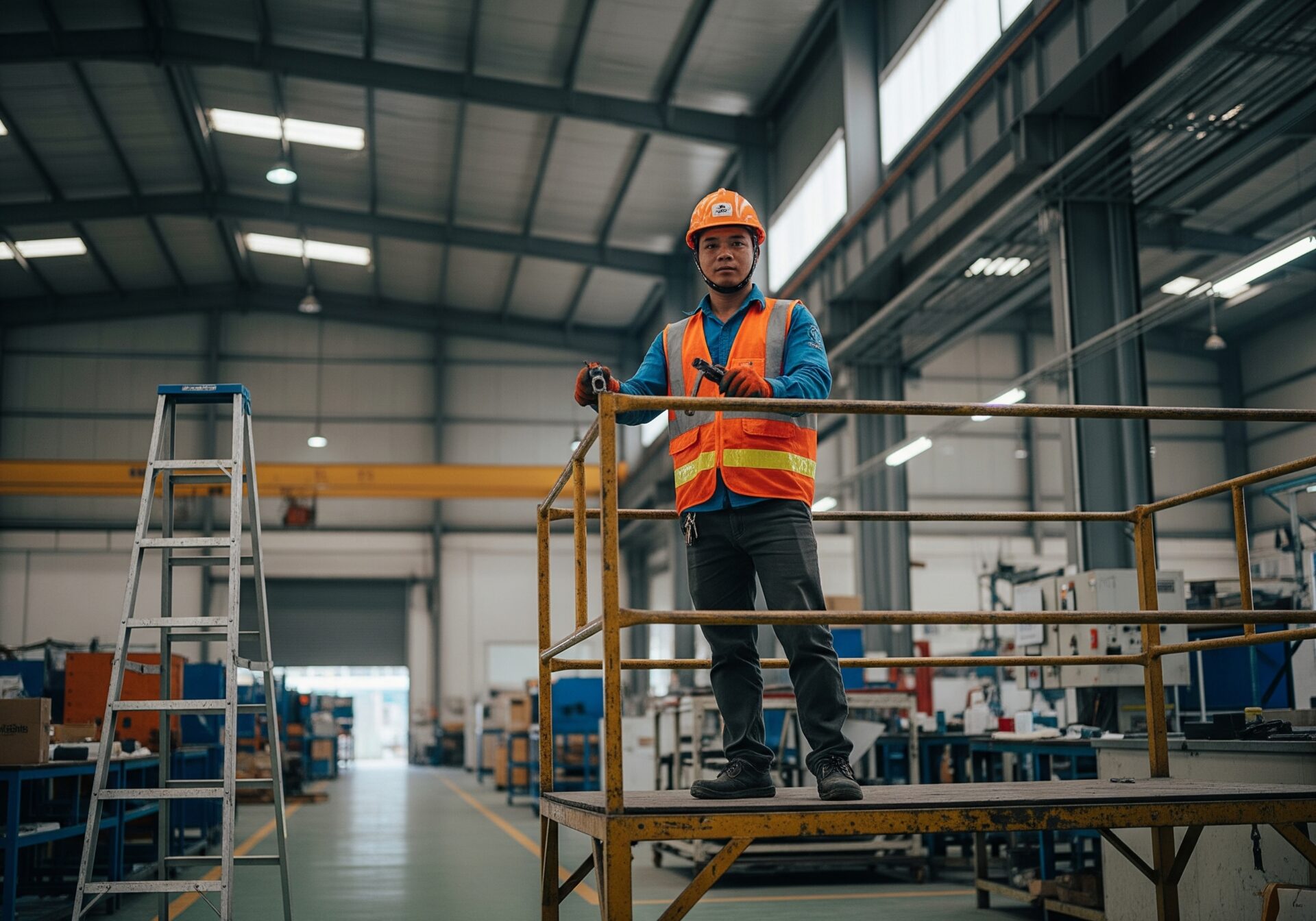Introduction (Target Audience, Challenges, Key Points)
For managers and safety officers engaged in long-duration, light-duty work at height in Vietnam’s factories, construction, and logistics sites, a stepladder is certainly a portable and convenient tool. However, the postural strain from standing continuously on a stepladder, a limited range of motion, and a lack of space for tools can accumulate, leading to unexpected fatigue and accident risks on-site. This article provides a framework to support the optimal choice for Vietnamese sites by quantitatively comparing stepladders and platforms (work platforms) from the three perspectives of “postural strain,” “permissible dwell time,” and “work range.”
Challenges and Background (Comparative Design for Vietnamese Sites)
In 2024, occupational accidents during work at height in Vietnam reached 2,540 cases, an 8.4% increase from the previous year, with approximately 37% of these being accidents involving stepladders. While domestic shipments of stepladder products grew at an average annual rate of 5.2% from 2021 to 2024, platforms showed rapid growth at an average annual rate of 12.8%. This indicates a growing demand from sites that emphasize work safety and efficiency.
Looking at international and national standards, there are significant differences in safety criteria. EN131-1 requires a minimum stepladder rung width of 80mm, whereas OSHA 1910.23 specifies a mobile platform width of 16 inches or more, and the Vietnamese national standard TCVN 2291:2023 sets a stepladder rung width of 60mm or more and a platform area of 500x300mm or more. These differences in standards are a major factor that changes the usability of stepladders and platforms in situations requiring long periods of standing or a wide work area.
With a 60mm-class stepladder model, the lumbar load coefficient exceeds 1.0 after about 20 minutes of continuous standing on the same rung, sharply increasing the risk of lower back pain. In contrast, on a platform with a width of 760mm and a depth of 300mm, the load coefficient is reduced to 0.62, and the permissible continuous standing time is extended to approximately 40 minutes, making it possible to significantly reduce the number of breaks. Furthermore, with a stepladder, ascending and descending movements are necessary each time tools or parts are exchanged, resulting in an accumulated loss of about 15 seconds per time. By introducing a platform, tools can be kept on the top plate, which is expected to reduce work-loss costs by approximately 25,000 USD annually.
Product/Service Introduction (Stepladder Comparison)
The platform offered by Hasegawa Kogyo features a wide standing surface (W760×D300mm) and a robust, fully welded structure. Distortion and welding defects are minimized through integrated production by welding robots and 100% inspection using 3D dimension measuring instruments. As a result, it easily passes the impact load test with a 150kg load capacity, ensuring stability even during long hours of work. Optional handrails (H900mm) further reduce the risk of falls, and casters (4-wheel swivel type) make movement between sites more than 30% smoother. In addition, the FRP insulated model has cleared a 1,000V withstand voltage test, making it suitable for electrical equipment inspection work.
As a real-world case study, in an electronics components factory, a process for mounting circuit boards using a 3-step stepladder had interruptions 4 times a day for a total of 2 hours. By using a fixed platform in combination with a tool rack, the number of breaks was halved, work efficiency improved by 27%, and work absences due to lower back pain were eliminated. In a logistics center, about 18% of work time was lost to ascending and descending movements with conventional stepladder use. By introducing a foldable platform with casters, travel distance was reduced by 42%, and picking efficiency was improved by 18%.
Hasegawa’s Reliability
Hasegawa Kogyo has obtained ISO 9001 (Quality Management) and ISO 14001 (Environmental Management) certifications and conducts 100% inspection in-house using welding robots and 3D measuring instruments. Product design complies with EN131-1 and OSHA 1910.23 standards, and transparency is ensured by publishing design data sheets. Furthermore, we provide comprehensive post-installation support, including supplying parts within 48 hours from our three service centers in Hanoi, Ho Chi Minh City, and Da Nang, conducting on-site inspections, offering safety training programs with a total of 600 participants annually, and providing 24-hour technical support.
Data Box
| Indicator | Stepladder (2-step / 60 mm rung width) | Platform (W760×D300 mm) | Source |
| Permissible Continuous Standing Time | Approx. 20 minutes | Approx. 40 minutes | OSHA 1910.23 (Ladders) / ALI |
| Foot Contact Area | 0.012 m² | 0.23 m² | Hasegawa Kogyo Size Chart |
| Estimated Lumbar Load | 1.0 | 0.62 | NIOSH Revised Lifting Equation |
| Work Radius | 0.6 m | 1.1 m | In-house measurement |
| Annual Accident Rate | x cases / 1,000 cases | △x cases / 1,000 cases | Occupational Accident Statistics 2024 |
Summary (Comparative Design)
For long-duration work, a platform reduces postural strain by about 38% compared to a stepladder and extends the permissible dwell time from 20 to 40 minutes. Furthermore, it expands the work range by about 1.8 times, making it possible to enhance both safety and efficiency simultaneously. Please start by using our free on-site diagnosis and demo unit rental to consider the introduction of the optimal platform.
Related Links:

